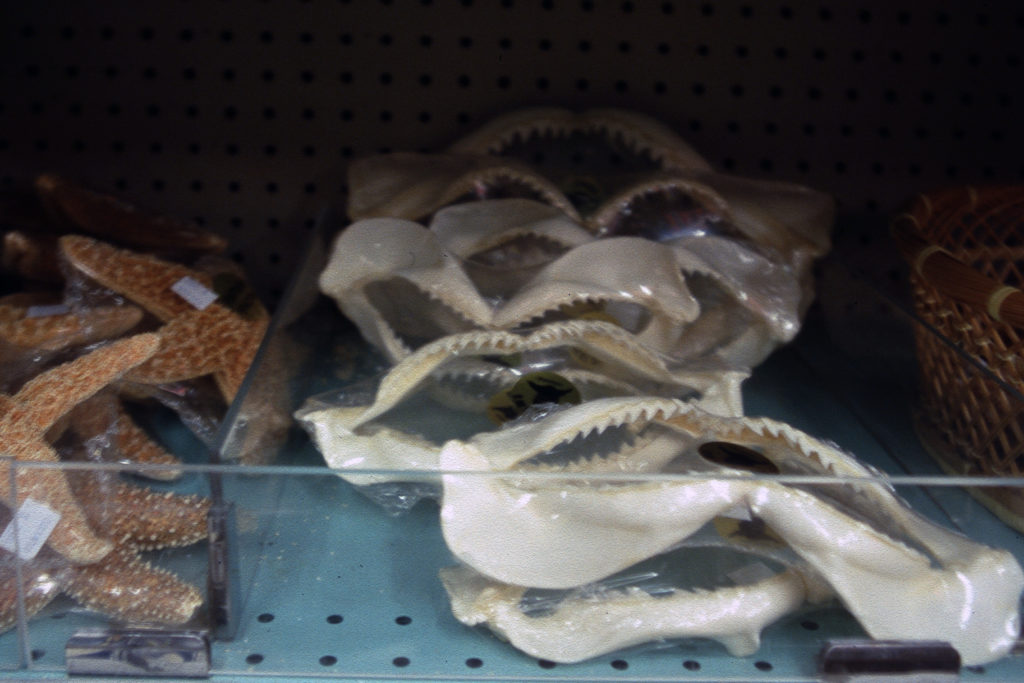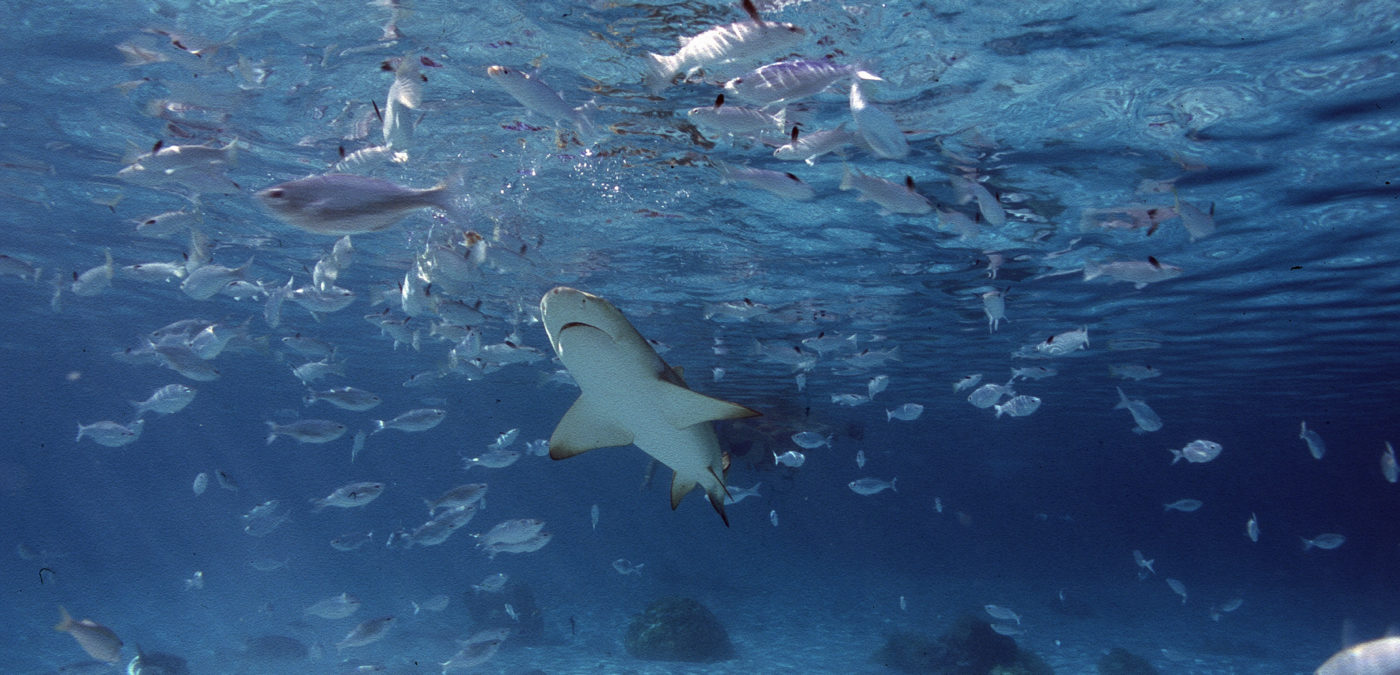Waiter, waiter, there’s a shark in my soup?
Imagine a place where you can see thousands of sharks, a whole range of species, and all before lunch… or rather for lunch. Here sharks no longer look powerful and beautiful. They have been literally stripped of all their power and grace, stripped of their fins which are then reduced to something which resembles a triangular piece of fiberglass. The fins have been sliced off the sharks, while the shark is still alive. Then, the incapacitated sharks are thrown back into the ocean to die a slow painful death. Welcome to the world of shark fin soup. Welcome to Hong Kong.
Shark fins are big business here. In fact, Hong Kong is the largest importer of shark fins in the world. On the back streets, behind all the skyscrapers and shopping malls, are the markets for the shark fin trade. I try to take everything in, almost getting knocked out the way, while a man runs by with a pig on his shoulder. The smells are suffocating and the things you see unfamiliar and, sometimes disturbing. Shark fins are just another selection on the menu here, along with snakes, frogs and deer tails. Fish are kept alive, crammed into polystyrene containers and occasionally being sprayed with water. Often you will see the shopkeeper grab a living fish and slice it open. Until now I never knew that the heart of a fish would still be beating when it’s in two pieces. A few more streets and eventually I make it to Des Voeux Road, or Dried Seafood Street, as it is also known. Quickly I come across shop after shop of shark fins for sale along with other seafood I have never seen before. Across the street I spot a shop advertising that it will, ‘buy and sell dried shark fins of all countries’. Peering into a few shops I quickly found it wasn’t easy to snoop around. The traders are suspicious of any foreigner who takes too much interest, and more than once I was told to go away. That day I gave up my investigation and asked for help from my contact Shelley, who had been collecting data in Hong Kong on the various types of shark fins for sale. She has often worked ‘undercover’. She gave me a leaflet advertising a dried seafood festival along with invaluable advice about approaching the traders. This leaflet was soon to become my passport to the shark fin shops of Hong Kong.
The next day and after a bit of hesitation I finally went undercover. My aim was to photograph what I had read about in so many magazines. You might have heard it too: 100 million sharks being killed each year, a good proportion being killed as a direct result of the shark fin soup trade. But have you ever seen the end result? Armed with my camera I walked into the shop, flashing around my seafood festival leaflet and trying to look as touristy as possible. I looked at everything offered on the shelves with curiosity, leaving the shark fins until last. On the wall a sign reads, ‘Import all kinds of raw sharks fins…Frozen sharks fins and all kinds of sharks fin products’. Finally, a shopkeeper came over to me and so I commented on all his ‘interesting foods’. When I had convinced him that I have no idea what I am doing or talking about, I ask if I can take a few photos, “I want to show my friends some pictures of your wonderful shop”. Flattery will get you everywhere. During my undercover missions I picked up a few more tricks, my favourite being, “Oh, sorry my camera is not working, it’s new!” As I pretend to wrestle with the shutter I sneak a few more photos. Shop after shop I pulled the same routine, I even found the courage to ask a few, more personal questions. “Do the shark fins taste nice?” The answer, “no, but the soup is nice, you soak it [the shark fin] and cook it with chicken stock”. Then I asked, “why do you eat it if you don’t like it?” The answer, “because it’s expensive, if it wasn’t expensive no one would buy it”. Today the serving and eating of shark fin soup is a sign of status and wealth more than anything else. Originally shark fins were bought by the rich and used for special occasions such as weddings. Today more people can afford it, and so the demand is increasing. I was asked if I wanted to buy a gift box of shark fins at $60. I said this was far too expensive so quickly he grabbed a tin of shark fin soup and tried to sell it to me for $12. I lied and told him, “I’m allergic to all seafood,” and walked away.
Making my way to Bonham Strand West, I saw the traders sorting the fins by the sack load. Unlike the other shops, here the fins are still grey waiting to be ‘stripped’ of their skin. With the shops full of these sacks the sheer number of sharks killed for the their fins becomes apparent and is heart breaking. The sacks are emptied out onto the floor and the fins sorted by size and type. The most expensive fin is the dorsal, followed by the pectoral, then the tail and finally the other ‘low grade’ fins. The larger the fin the higher the price, but that still doesn’t limit the amount of very small fins collected for sale. These are probably from immature sharks and as sharks are long lived and slow to mature, the shark populations are greatly affected. So here in Hong Kong anything goes, the species doesn’t seem to matter, and usually they have no idea what shark it is that the fin has been taken from. Hung on the walls is different types of shark jaws and shark posters, but pride of place is the trophy fins. Often wrapped with a red ribbon, these fins are huge. I was standing in front of a glass case containing several of these trophy shark fins. I asked the shopkeeper what type of shark it is from. She looked at me slightly confused and then pointed to her shark wall chart, ” It’s this shark, a very large shark,” she had pointed to the largest and greatest, the Great White.
The fins of the sharks I saw have come from all over the world. Targeted in even the smallest Pacific Island, there is no escape. In one Pacific Island library I picked up a book titled, ‘So You Want to Sell Some Shark Fin? A Manual for Rural Fishermen’. Inside it tells you everything from how to catch sharks to how to sell fins, with an emphasis on making sure you get the most for your money. Shark finning is illegal in the EC, Australia, USA, Brazil and Costa Rica, but the traders in Hong Kong are still importing a lot of fins. They are their own isolated world that doesn’t want to know about the damage that an expensive bowl of soup can do…or maybe they just don’t understand? If you have a leaflet given to you, by the ‘Chinese Herbs and Dried Sea Food Festival’ you have no reason to question what it says. I was given a recipe book that reads, “the gelatine strands of the fins of sharks, rich in protein and nutritious values, a seafood by-product gaining worldwide acceptance”. Nutritious, shark fins, worldwide acceptance, these words don’t belong in the same sentence. People need to realise that the shark is an apex predator and without them the oceans ecosystems will eventually collapse. Is it worth destroying our oceans for a bowl of soup and the status that it buys? That afternoon feeling sad and angry I passed a shark fin soup restaurant. I have heard that it costs over $100 for a bowl of shark fin soup, a $100, I would rather invest, to keep the sharks out the soup and in the oceans where they belong.

Published in Shark Diver magazine March 2003
